|
March 1958 Popular Electronics
 Table
of Contents Table
of Contents
Wax nostalgic about and learn from the history of early electronics. See articles
from
Popular Electronics,
published October 1954 - April 1985. All copyrights are hereby acknowledged.
|
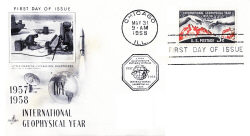
International Geophysical Year First Day Cover
The International Geophysical Year (IGY) was an international scientific
project that took place from July 1, 1957, to December 31, 1958. It was a
collaborative effort involving scientists from around the world to conduct
research in various fields of geophysics. The IGY was organized in response to a
proposal by the International Council of Scientific Unions (ICSU) to promote
international cooperation in the study of the Earth and its environment. The
project aimed to advance our understanding of Earth's physical properties,
including its atmosphere, oceans, and solid Earth. During the IGY, scientists
conducted research in a wide range of disciplines, such as meteorology,
seismology, glaciology, oceanography, and solar physics. They used cutting-edge
technologies and established numerous research stations across the globe to
gather data. One of the most significant achievements of the IGY was the
International Geophysical Year Antarctic Program. Several countries established
research bases in Antarctica, leading to significant discoveries about the
continent's geology, weather patterns, and wildlife. The IGY also witnessed
notable milestones in space exploration. In 1957, the Soviet Union launched the
first artificial satellite, Sputnik 1, marking the beginning of the Space Age.
This event generated worldwide excitement and intensified the focus on space
research during the IGY.
Electronics
and IGY
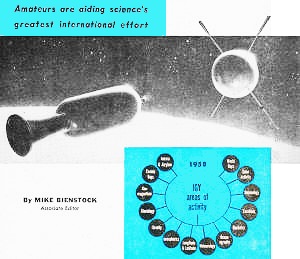 Amateurs are aiding science's greatest international
effort Amateurs are aiding science's greatest international
effort
By Mike Bienstock
Associate Editor
Scientists are in the midst of a concerted assault on the secrets of Mother Earth
the likes of which have never before been attempted. The International Geophysical
Year will not end until December 31, but by that time some 5000 scientists of 67
nations will have accumulated enough data to keep electronic computers clacking
for years. The results, when they finally become known, are expected to increase
the knowledge of the planet we inhabit by a thousandfold. We Earthlings are compressed
between two oceans - the mass of atmosphere extending above us for 200 miles or
more, and the mass of water, plumbed to a depth of more than 35,000 feet. We are
familiar with just the fringes of these oceans, and even there the acquaintance
is only nodding. Of the land area of our world, our deepest oil well has only scratched
the surface. We barely have touched the edges of Antarctica.
It has been said that we know more about the stars, since we are able to stand
off and take a good look at them, while here on Earth, so close to our subject,
we grow cross-eyed trying to view the "big picture." Actually, it is suspected that
we are off several hundred feet in our measurement of distances between continents.
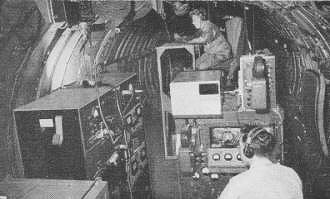
Interior of aircraft instrumented for ionospheric
research. The instrument in the foreground measures the heights of the layers in
the ionosphere using vertical incidence pulses.
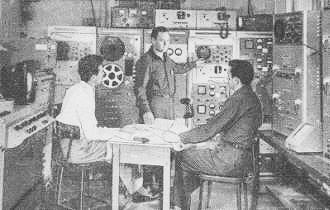
Measuring telemetered data from rockets in flight
at an installation in Manitoba, Canada. At the far left is a telemetry recorder
which takes data from airborne rockets; in the center is the main recorder which
puts data on tape; the ballistic camera master control is at the right.
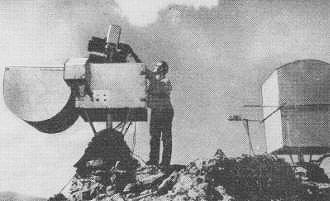
Scanning photoelectric photometer selects and
measures the intensity of light too faint for the human eye and records its changes.
This airglow camera is at Fritz Peak, Colorado.
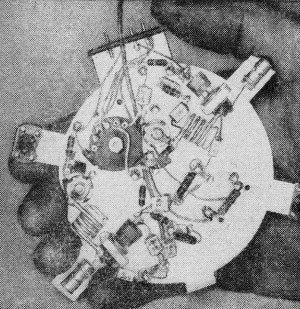
Radio transmitter with a 4000-mile range is
part of the electronic instrumentation of the U.S. earth satellite.

Also in the tiny "moon" is a 48-channel encoder
which receives and encodes data from other satellite instruments for transmittal
back to the earth.
Fields of Research. The IGY has planned, since 1954, to concentrate
in one 18-month period investigation into the fields of aurora and airglow, cosmic
rays, geomagnetism, glaciology, gravity, ionospherics, longitude and latitude, meteorology,
oceanography, rocketry, satellites, seismology, solar activity and "World Days."
The latter are periods of all-out concentration on one subject when there is sufficient
warning of some unusual event in that field, for example, sunspot activity.
Most of the effort is being devoted to the atmosphere and the electrical phenomena
which occur there.
Besides the professional scientists giving all their energies to IGY, thousands
of amateurs volunteer time as observers to aid the effort. Project Moonbeam, organized
to use the abilities of radio amateurs and others, has been vital in tracking the
earth satellites, despite the fact that the observers were forced to make a quick
switch from 108 mc. (the frequency originally decided upon) to 20 and 40 mc., which
the Soviet Sputniks employed.
Tracking Systems. The primary system for tracking satellites
by radio and recording their telemetered signals is the "picket fence" of Minitrack
stations manned by professionals. The supporting Moonbeam program uses a simpler
Mark II Minitrack system as well as a different setup, Microlock. Both use phase
comparison techniques, and the equipment is simple enough to be built by amateurs.
In addition to radio tracking, visual and photographic observations are used
by amateur groups.
While the satellites thrown into orbit by the Soviets and the United States are
expected to reveal an astonishing amount of information in regard to the nature
of the upper atmosphere, cosmic rays, auroras and the ionosphere, other devices
mainly dependent on electronics are already contributing extensive data to the effort.
For instance, radiotelescopes around the world are concentrating their antennas
on the sun. Sunspots seem to be related to tremendous explosions on the sun that
shoot out streams of charged particles, ultraviolet light and x-rays. Immediately
after such "storms" on the sun, violent atmospheric disturbances occur. Very quickly
short-wave communications fade, auroras burst forth in the northern and southern
skies, cosmic ray intensity increases and the magnetic field of the earth shifts
rapidly.
Strangely enough, not all sun "storms" cause these upheavals on earth. One of
the things IGY is attempting to discover is the reason for this. Strangely enough,
not all sun "storms" cause these upheavals on earth. One of the things IGY is attempting
to discover is the reason for this.
All during IGY, when such storms are detected, the world warning center at Fort
Belvoir, Va., will be sending out alerts for special "World Days," during which
scientists concentrate all of their energies on measuring whatever disturbances
may occur. Up go "rockoons" (rockets launched from balloons) and Aerobee rockets
fitted with delicate instruments to measure the intensities of x-rays, cosmic rays,
ultraviolet radiation and such. A close check on the "shifting" of the E and F layers
of the ionosphere is kept to determine the relationship of sunspots to such movements.
Already a new layer of ionization, 12 miles below the lowest point, has been discovered.
It was learned that this new layer was caused by solar x-ray emission associated
with solar flares. Meanwhile, the normal layers of ionization, E and F, seem to
remain stationary during a blackout, contrary to former opinion. It may be, therefore,
that radio blackouts are caused by signal absorption in the newly discovered layer.
Watch on the Mountain. A new instrument, the recording photometer,
keeps watch on Fritz Peak, Colorado, to determine the change in the intensity of
air-glow - a light so faint we can barely see it. This phenomenon is believed to
come from some chemical reaction of oxygen, sodium and other ions in the D layer,
about 60 miles up, and may be affected by solar storms.
Cosmic rays are getting the once-over for another reason: they give us an important
clue to the character of the earth's magnetic field. Since they are charged particles,
they are deflected by the earth's magnetic lines of force. Near the magnetic poles,
where the lines are nearly vertical, there is little deflection, and therefore a
greater intensity of cosmic radiation than along the magnetic equator, where the
lines are close to horizontal. About 100 stations around the earth are measuring
constantly the strength of cosmic rays, using two delicate electronic instruments,
a neutron counter, sensitive to low-energy rays, and a meson "telescope," more sensitive
to high-energy radiation. Collating the hundreds of thousands of readings of these
instruments, scientists should be able to obtain a much better understanding of
the shape and intensity of the earth's magnetic field.
Another important study will be that of "whistlers," faint chirping and whistling
noises discovered during the First World War. Back in 1950 it was learned that these
noises are actually caused by low-frequency waves from lightning discharges, which
follow the earth's magnetic lines of force from the point of origin, out into space,
and back along the lines to the opposite hemisphere.
A huge antenna has been erected across a ravine in Colorado which is used to
pick up these whistlers. A field station nearby amplifies them and records them
on tape for future study. Another form of whistle is also being recorded there -
the "dawn chorus." These noises, reminiscent of the pipings of frogs at dawn, are
thought to be caused by streams of hydrogen ions at the edge of the atmosphere.
Study may be able to correlate these noises with the intensity of solar storms.
With the advent of the forward scatter technique, which utilizes the ionosphere
to bounce signals back to earth hundreds of miles away, engineers are anxious to
learn all they can about this unreliable phenomenon so they can use it more effectively.
The National Bureau of Standards has set up test transmitters in South America
to use the forward scatter technique across the magnetic equator. It is suspected
that this method will be especially effective because the ionization layer theoretically
should line up with the magnetic lines of force, thus making for more even scatter
propagation. Again the radio amateurs assist in the IGY program, since many of them
listen for these transmissions, especially in the western part of the country and
in Mexico, and send their reports to the Bureau of Standards.
Auroras. Another important study is that of auroras. These intensely
beautiful phenomena are believed to be set off by streams of hydrogen ions caused
by solar storms. The ions are thought to react with the atoms of the upper atmosphere
and make them glow like a fluorescent lamp. Some scientists had thought that auroras
should occur simultaneously at both of the poles. This has now been established
as a fact. Amateur astronomers have been recording the shape and intensity, as well
as the angle above the horizon, of auroras in the upper northern regions. Concurrent
investigations by meteorologists at the South Pole made the confirming study.
It is believed that auroras occur in day-time, although they can't be seen then.
Therefore, observers near the auroral zone use sensitive radars to try to pick up
reflections from the electron clouds which accompany auroras during daylight hours.
Although the IGY program will end officially Dec. 31, 1958, a good many projects
will continue in operation. As a matter of fact, they may be prolonged indefinitely,
especially those that are fairly inexpensive to maintain.
World data centers are being planned in the United States, the Soviet Union and
other areas, in which digested results of the observations will be filed for scientists.
It is not expected that such results will be put into usable form before 1965, but
after that date science textbooks may have to be thoroughly rewritten because of
IGY's results.
Posted June 1, 2023
(updated from original post
on 7/31/2012)
|










 Amateurs are aiding science's greatest international
effort
Amateurs are aiding science's greatest international
effort 




